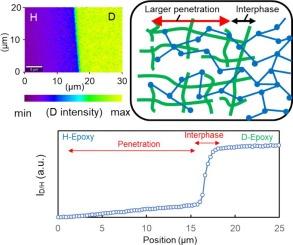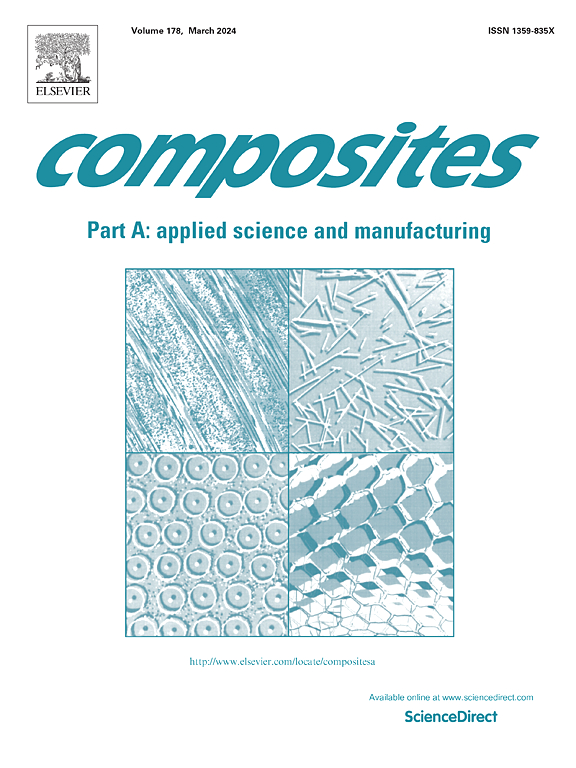Analyses and control of interphase structures and adhesion properties of epoxy resin/epoxy resin for development of CFRP adhesion systems
IF 8.1
2区 材料科学
Q1 ENGINEERING, MANUFACTURING
Composites Part A: Applied Science and Manufacturing
Pub Date : 2024-10-09
DOI:10.1016/j.compositesa.2024.108511
引用次数: 0
Abstract
In the adhesion of carbon fiber reinforced plastics (CFRP), the boundary regions were composed of only epoxy resins of CFRP matrix and adhesives, and their similar epoxy structures pose significant difficulty in studying the adhesion mechanism. Herein, we focused on structure and properties of laminates of epoxy resin substrates and adhesives with different curing conditions of substrates. We prepared laminates using deuterated epoxy adhesives or fluorinated epoxy adhesives, and their boundary regions were identified through confocal Raman scattering measurements. The regions were distributed into “penetration” and “interphase”. In particular, the penetration phase is a key of the adhesion properties. The penetration behaviors strongly depended on the crosslinking densities of the adherends, suggesting that the penetration regions would be directly impacted by the curing conditions of the substrates and molecular size of epoxy adhesive precursors. Our findings provide insights into novel designs of the reliable adhesion-based manufacturing systems of CFRP.

分析和控制环氧树脂/环氧树脂的相间结构和粘附性能,以开发 CFRP 粘附系统
在碳纤维增强塑料(CFRP)的粘合过程中,边界区域仅由碳纤维增强塑料基体的环氧树脂和粘合剂组成,其相似的环氧树脂结构给研究粘合机理带来了很大的困难。在此,我们重点研究了环氧树脂基体和粘合剂在不同固化条件下的层压板结构和性能。我们使用氚化环氧树脂粘合剂或氟化环氧树脂粘合剂制备了层压板,并通过共焦拉曼散射测量确定了它们的边界区域。这些区域被分为 "渗透相 "和 "相间相"。其中,渗透相是粘合性能的关键。渗透行为在很大程度上取决于粘合剂的交联密度,这表明渗透区域会受到基材固化条件和环氧树脂粘合剂前体分子大小的直接影响。我们的研究结果为基于粘合剂的 CFRP 可靠制造系统的新型设计提供了启示。
本文章由计算机程序翻译,如有差异,请以英文原文为准。
求助全文
约1分钟内获得全文
求助全文
来源期刊

Composites Part A: Applied Science and Manufacturing
工程技术-材料科学:复合
CiteScore
15.20
自引率
5.70%
发文量
492
审稿时长
30 days
期刊介绍:
Composites Part A: Applied Science and Manufacturing is a comprehensive journal that publishes original research papers, review articles, case studies, short communications, and letters covering various aspects of composite materials science and technology. This includes fibrous and particulate reinforcements in polymeric, metallic, and ceramic matrices, as well as 'natural' composites like wood and biological materials. The journal addresses topics such as properties, design, and manufacture of reinforcing fibers and particles, novel architectures and concepts, multifunctional composites, advancements in fabrication and processing, manufacturing science, process modeling, experimental mechanics, microstructural characterization, interfaces, prediction and measurement of mechanical, physical, and chemical behavior, and performance in service. Additionally, articles on economic and commercial aspects, design, and case studies are welcomed. All submissions undergo rigorous peer review to ensure they contribute significantly and innovatively, maintaining high standards for content and presentation. The editorial team aims to expedite the review process for prompt publication.
 求助内容:
求助内容: 应助结果提醒方式:
应助结果提醒方式:


